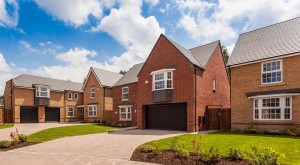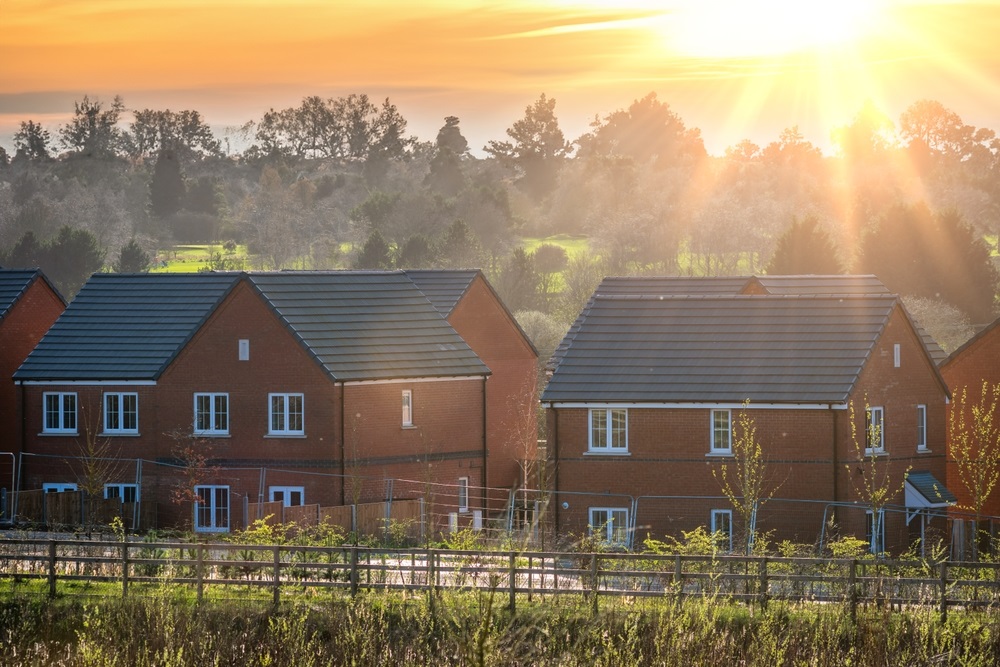Buying a house is one of the biggest financial decisions you will make so what type of property you choose is paramount. Richard Sexton, business development director of e.surv chartered surveyors, considers the pros and cons of whether to buy an older property or opt for a new build What makes somebody buy old or […]
Buying a house is one of the biggest financial decisions you will make so what type of property you choose is paramount. Richard Sexton, business development director of e.surv chartered surveyors, considers the pros and cons of whether to buy an older property or opt for a new build
What makes somebody buy old or buy new? It’s one of the key decisions for home-movers, and if considered is one quick way of narrowing your options. One of the first questions an estate agent will likely ask you is ‘are you interested in an older or newer property?’
Perhaps individual stylistic preferences reflect a former family home, a property described in a favourite book, or even a memorable trip to a National Trust property while you were young. Do today’s modern city workers always want modern pads to match?
Either way, the question of property age can impact the comfort, running costs, and longevity of your potential home – so your choice could impact your emotional and financial health. This means it’s wise to leave aside the emotional pull of a property preference, and assess the practical pros and cons of both options before you buy.
First-time buyers
The estate agents Your Move and Reed Rains’ latest First Time Buyer Opinion Barometer reveals that the average price of a first-time buyer home in the UK is approximately £158,000 while the Council of Mortgage Lenders report that the average first-time buyer salary is £39,000; so buying a house will typically cost over four years’ worth of your salary. Factor in the years of saving for a deposit, the costs involved in moving and the stress of competing against other buyers, and the pressure to make the right decision is obvious.
Deciding how to spend your budget is the first step. For example, in Birmingham, £277,000 could buy you a new, detached property with three bedrooms, a good sized living room, and a modern kitchen with new appliances, but only a rear garden. Contrastingly, in the same region, you could opt for an older, semi-detached property with five bedrooms, three living rooms, a basement, and a large front and rear garden, although no new appliances or modern looking exterior. It’s a question of priorities.
Help to Buy schemes
For first-time buyers contemplating the old or new question, financial support is available for both routes. Help to Buy (see page 32 for more details), the government’s flagship housing policy, has options for all property types. The Equity Loan scheme allows first-time buyers and home-movers to take out interest-free loans worth 20 per cent of the property’s value if they contribute a deposit of at least 5 per cent themselves – but can only be used if buying a new build up to the value of £600,000.
Meanwhile the Mortgage Guarantee scheme, or Help to Buy 2, is available on all properties up to £600,000 – not just new builds. Tax-payer cash is used to underwrite 15 per cent of the value of a mortgage when a lender offers a loan to buyers with deposits of just 5 per cent. This encourages lenders to offer more options to borrowers with smaller deposits, and to offer these at more affordable rates.
The final option in the triad – the Help to Buy ISA – offers first-time buyers a bonus of up to £3,000 on their savings for a deposit. This is due to come into effect this autumn and again can be used to help with the purchase of both old and new properties.
Although they want to encourage more housebuilding, the government isn’t offering a particular incentive to buy old or buy new – meaning financial support shouldn’t skew your decision.
Are doer-uppers worth the stress?
While assessing value for money and what you can afford are essential when buying a house, it’s also wise to keep a watchful eye out for the potential for adding value to a property. At some point, you will most likely wish to trade-up, or indeed expand or adapt your property.
The popularity of the ‘doer-upper’ has sky-rocketed over the last decade thanks to programmes like Sarah Beeny’s “Property Ladder,” which showcases how home improvements can benefit the re-sale value of a house.
There is also a rising trend in homeowners extending and reorganising their homes to save on moving costs like stamp duty. Although the revision of bandings for this moving tax has helped ease this burden – particularly at the lower end – the cost of moving remains significant, so buying a house with room for expansion can be a smart move.
But how should you finance these extra works? There tends to be two approaches to this dilemma. The first is to hold some savings back from a deposit to spend on the renovations, and take out a larger mortgage instead – allowing you the upfront cash to get home improvements underway quickly. Alternatively, some buyers prefer to put down as large a deposit as possible – to access the cheaper rates on offer – and carry out home improvements over a period of time, as and when they can afford them.
If you have major works in mind, it’s also important to investigate the likelihood of getting planning permission before putting in an offer, as well as carefully budgeting the cost of the works.
Identikit houses or tailor-made?
The idea of living in an unfinished house doesn’t appeal to everybody. And you don’t have to buy old to get a place with character.
If you’re buying new, a developer will often customise your house to your personal taste as it is being built – cutting down the need for redecorating or reorganising further down the line.
What’s more, technologies like alarm systems, underfloor heating, sound systems and broadband will often be automatically designed in. Due to the energy efficiency standards required of new homes, the cost of running new builds will generally be lower, as modern boilers are fitted, walls and roofs are insulated and windows will be double or triple glazed.
Even better, new houses are designed with the modern family in mind: walk-in wardrobes, large master bathroom, open kitchen area where the whole family can eat together. All your appliances will work, everything will be clean, and maintenance should be easier.
However, with luxury comes cost. All of those upgraded features that you saw in the model house will add to the asking price as you incorporate them into your build, so buyers can easily spend more than originally planned.
Uncover the hidden costs
Of course, making sure you’re paying the right price is probably the most important step in the homebuying process. After all, if you’re paying over the odds for a property you may not be able to get a mortgage to cover the cost.
A mortgage valuation will confirm the value of your future property for a lender, but it won’t uncover any potential pitfalls that could add extra costs after your move.
Therefore, for second hand property in particular, it is highly recommended to commission an additional private survey, to equip you with detailed knowledge on your property before you buy. These surveys can cost as little as £250 – with the depth of detail dependent on the survey type required.
A RICS (Royal Institution of Chartered Surveyors) HomeBuyer Report will detail major structural issues like dampness and subsidence as well as providing a valuation and insurance reinstatement value. It will provide guidance on necessary repairs and maintenance costs, and could uncover costly defects.
For older properties (over 100 years old) or unusual building types, it is recommended to instruct a comprehensive RICS Building Survey, which will uncover any problems which are more difficult to find. This survey is more expensive (typically between £500 and £1,000) but provides essential information when buying a doer-upper, a building that has had major alterations, or are planning a significant reorganisation. After all, if a survey uncovers a need for £10,000 worth of repairs, you will be in a good position to negotiate down the asking price.
New builds are a slightly different story. The National House-Building Council (NHBC) Warranty places responsibility for defects during the first two years on the builder, and for the following eight years on the NHBC.
When purchasing a new house, inquire what type of guarantee it comes with. If you’re interested in a house that’s just a few years old, find out if it still has one. Surveys are less important in this scenario but you may wish to seek independent advice to ensure you aren’t paying over the odds.
Surrounding area
One of the biggest differences between old and new houses can be the land and surrounding area.
A report on the size of new houses in the UK from the Royal Institute of British Architects (RIBA) found that new homes are shrinking in size with the average new home in England only 92 per cent of the recommended minimum size, and found new homes in the UK to be the smallest in Western Europe.
Meanwhile, the average plot size on which a house is built has shrunk from 502m² to 282m². One place this is particularly evident is in the garden, with the spaces provided in new builds often more limited, as well as lacking the mature shrubs and flower beds found in older properties.
Convenience matters too. As competing demands for land grows, the location for many new build developments can be further from the centre of town than you may wish.
Whether old or new, remember that ultimately, whilst it’s possible to add personality to both, it’s impossible to change their location!
[box style=”2″]
Case study: London workers opt for out of town older home
First-time buyers Venita Nordon (26) and Adam Kirby (26) have recently exchanged contracts on a three-bedroom semi-detached house in Woking, Surrey.
semi-detached house in Woking, Surrey.
– Why did you opt to buy an older property rather than a new build?
Above all, it came down to what we could afford. It quickly became clear that older properties tend to offer a better deal in terms of how much space you can get for your money. By finding an old property we’ve found a way to gradually create the home we can’t otherwise afford.
We also wanted somewhere that came with character. Features matter too, for example, fireplaces are a real plus in the winter.
– Were you looking for a particular style of property?
After living in rented flats in London for years, we knew that outdoor space was important to us, even if it was just a balcony. We’ve both always wanted a garden, so that and the satisfaction of owning the freehold pushed us towards buying a house. A large detached property is unrealistic at this stage, but a terraced property with a small garden was what we had in mind when we started looking.
– How important was location to your decision to buy?
We both work in London and only one of us has a driving license, so being within a realistic walking distance of public transport was essential. We looked at a few places we thought we might be able to afford within Greater London, but after considering the commute we realised that the places we could afford would have a ridiculously long commute. We quickly settled on living in a town somewhere further from the city, but on a fast train line.
– Did you commission a survey on the property before exchanging?
Luckily, we commissioned a full building survey, but only after we spotted some peeling wallpaper might hide more serious problems.
When we got the results it turned out practically the whole house is suffering from rising damp. The thick layer of outside paint around the whole building needs removing and most of the walls need re-pointing. Inside, we’ll need to have a good proportion of the walls replastered. What’s more, the survey found some evidence of asbestos in the plasterwork of the ceilings, which shouldn’t need disturbing, but we’d rather be aware of it.
In total, we managed to negotiate £12,750 off the original price we’d previously offered and the seller had already accepted.
– How do you intend to fund any renovations?
The money we negotiated off the purchase price should fund the major work to the exterior walls and all the replastering. Alongside some spare savings that also means we should be able to pay for the central heating to be installed in the first few months of moving in. Beyond that, most things will be a work in progress for the next few years.
– Are there any particular features that you plan to add to the house?
Looking further ahead, we’re planning to funnel any gradual savings into redecorating – while in the future big projects will be a modern kitchen and a more comfortable bathroom.
[/box]















